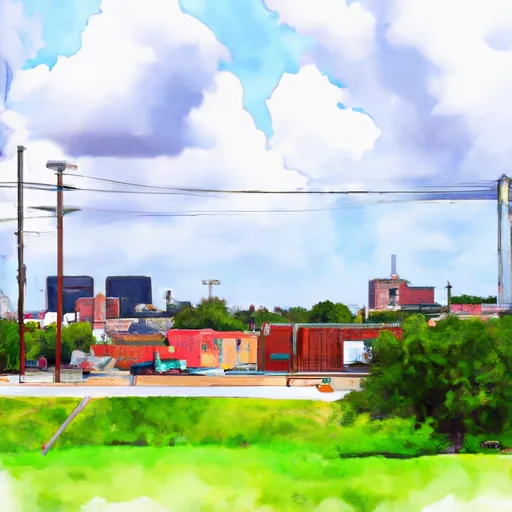-
 Snoflo Premium
Snoflo Premium
Get unlimited access to all our content
With no Ad interruptions! - Start Your Free Trial Login with existing account
Raywood
Eden Index
Climate
6.9
•
Recreation
3.1
•
Community
•
Safeguard
3.9/10

Raywood, Texas is a small unincorporated community located in Liberty County, southeast Texas. The region experiences a humid subtropical climate characterized by hot summers and mild winters. Summers are usually hot and humid, with temperatures frequently exceeding 90°F (32°C), while winters are generally mild with temperatures in the 50s°F (10-15°C). Rainfall is evenly distributed throughout the year, with the wettest months being May and June.
Hydrology constituents in Raywood are influenced by the Trinity River, which flows nearby. The river serves as a crucial water source for the region and supports various wildlife and vegetation. The area is also dotted with numerous ponds and lakes, presenting opportunities for fishing, boating, and other water-based activities.
Raywood and its surrounding areas offer several outdoor recreation opportunities. The Trinity River Wildlife Management Area is a popular destination for hunting, birdwatching, and hiking. Nature enthusiasts can explore the diverse ecosystems and observe wildlife such as white-tailed deer, waterfowl, and alligators. Additionally, nearby Lake Anahuac Park provides opportunities for camping, picnicking, and fishing. With its pleasant climate and abundant natural resources, Raywood is an ideal location for outdoor enthusiasts seeking to connect with nature.
What is the Eden Index?
The Snoflo Eden Index serves as a comprehensive rating system for regions, evaluating their desirability through a holistic assessment of climate health, outdoor recreation opportunities, and natural disaster risk, acknowledging the profound impact of these factors on livability and well-being.
Climate Health Indicator (CHI): 6.9
Raywood receives approximately
1461mm of rain per year,
with humidity levels near 90%
and air temperatures averaging around
21°C.
Raywood has a plant hardyness factor of
9, meaning
plants and agriculture in this region tend to thrive here all year round.
By considering the ideal temperature range, reliable water supplies, clean air, and stable seasonal rain or snowpacks, the Climate Health Indicator (CHI) underscores the significance of a healthy climate as the foundation for quality living.
A healthy climate is paramount for ensuring a high quality of life and livability in a region, fostering both physical well-being and environmental harmony. This can be characterized by ideal temperatures, reliable access to water supplies, clean air, and consistent seasonal rain or snowpacks.
Weather Forecast
Streamflow Conditions
Lower Trinity
Area Rivers
Lower Trinity
Snowpack Depths
Lower Trinity
Reservoir Storage Capacity
Lower Trinity
Groundwater Levels
Recreational Opportunity Index (ROI): 3.1
The Recreational Opportunity Index (ROI) recognizes the value of outdoor recreational options, such as parks, hiking trails, camping sites, and fishing spots, while acknowledging that climate plays a pivotal role in ensuring the comfort and consistency of these experiences.
Access to outdoor recreational opportunities, encompassing activities such as parks, hiking, camping, and fishing, is crucial for overall well-being, and the climate plays a pivotal role in enabling and enhancing these experiences, ensuring that individuals can engage in nature-based activities comfortably and consistently.
Camping Areas
| Campground | Campsites | Reservations | Toilets | Showers | Elevation |
|---|---|---|---|---|---|
| Alabama - Coushatta Lake Tombigbee | 134 | 278 ft | |||
| Dellanera City RV Park | 63 | 6 ft | |||
| Double Bayou County Park | None | 11 ft | |||
| Hugo Point County Park | None | 28 ft | |||
| Job Beason County Park | None | 5 ft | |||
| Fort Anahuac County Park | None | 20 ft | |||
| James H. Robbins Memorial Park | None | 3 ft | |||
| White Memorial County Park | 15 | 28 ft | |||
| Rollover Pass | 40 | 3 ft | |||
| McCollum County Park | None | 27 ft |
Nearby Fishing
Catastrophe Safeguard Index (CSI):
The Catastrophe Safeguard Index (CSI) recognizes that natural disaster risk, encompassing floods, fires, hurricanes, and tornadoes, can drastically affect safety and the overall appeal of an area.
The level of natural disaster risk in a region significantly affects safety and the overall livability, with climate change amplifying these risks by potentially increasing the frequency and intensity of events like floods, fires, hurricanes, and tornadoes, thereby posing substantial challenges to community resilience and well-being.
Community Resilience Indicator (CRI):
The Community Resilience Indicator (CRI) recognizes that education, healthcare, and socioeconomics are crucial to the well-being of a region. The CRI acknowledges the profound impact of these elements on residents' overall quality of life. By evaluating educational resources, healthcare accessibility, and economic inclusivity, the index captures the essential aspects that contribute to a thriving community, fostering resident satisfaction, equity, and social cohesion.

